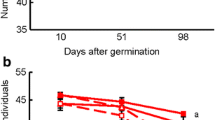Summary
The relationship between roots of Carex firma, C. sempervirens and their commonly occuring dark septate fungal associates was examined. Two typical fungal associates were isolated and reinoculated onto aseptically grown seedlings of the two host species. Both isolates produced significant increases of dry matter production in C. firma compared with uninoculated controls. No growth stimulation was obtained in C. sempervirens. Shoot phosphorus concentrations were significantly increased in both host species by inoculation. The absence of growth stimulation in C. sempervirens may be due to carbon drain imposed by the fungus or to the fact that nutrients other than phosphorus are growth limiting. The nature and possible ecological significance of the root-fungus association is discussed and it is suggested that the relationship is mutualistic rather than parasitic.
Similar content being viewed by others
References
Cain RF (1952) Studies on fungi imperfecti. I. Phialophora. Can J Bot 30:338–343
Davies J, Briarty LG, Rieley JO (1973) Observation on the swollen lateral roots of the Cyperaceae. New Phytol 72:167–174
Deacon JW (1973) Phialophora radicicola and Gaeumannomyces graminis on roots of grasses and cereals. Trans Br mycol Soc 61:471–485
Haselwandter K, Read DJ (1980) Fungal associations of roots of dominant and sub-dominant plants in high-alpine vegetation systems with special reference to mycorrhiza. Oecologia (Berl) 45:57–62
Hewitt EJ (1966) Sand and water culture methods used in the study of plant nutrition, 2nd ed. Commonwealth Agricultural Bureaux, Frankam Royal, Bucks, England
Michelsen OB (1957) Photometric determination of phosphorus as molybdovanadophosphoric acid. Anal Chem 29:60–62
Peyronel B (1924) Prime ricerche sulle micorrize endotrofiche e sulla microflora radicicola normale delle fanerogame. Riv Biologia 6:17–53
Read DJ, Haselwandter K (1981) Observations on the mycorrhizal status of some alpine plant communities. New Phytol 88:341–352
Rehder H (1976a) Nutrient turnover studies in alpine ecosystems. I. Phytomass and nutrient relations in four mat communities of the Northern Calcareous Alps. Oecologia (Berl) 22:411–423
Rehder H (1976b) Nutrient turnover studies in alpine ecosystems. II. Phytomass and nutrient relations in the Caricetum firmae. Oecologia (Berl) 23:49–62
Rehder H, Schäfer A (1978) Nutrient turnover studies in alpine ecosystems. IV. Communities of the Central Alps and comparative survey. Oecologia (Berl) 34:309–327
Saksena HK, Vaartaja O (1960) Descriptions of new species of Rhizoctonia. Can J Bot 38:931–943
Sanders FE, Mosse B, Tinker PB (1975) Endomycorrhizas. Academic Press, London-New York-San Francisco
Stribley DP, Tinker PB, Rayner JH (1980) Relation of internal phosphorus concentration and plant weight in plants infected by vesicular-arbuscular mycorrhizas. New Phytol 86:261–266
Wilmanns O (1978) Ökologische Pflanzensoziologie. Quelle & Meyer, Heidelberg
Author information
Authors and Affiliations
Additional information
Nomenclature follows Wilmanns 1978
Rights and permissions
About this article
Cite this article
Haselwandter, K., Read, D.J. The significance of a root-fungus association in two Carex species of high-alpine plant communities. Oecologia 53, 352–354 (1982). https://doi.org/10.1007/BF00389012
Received:
Issue Date:
DOI: https://doi.org/10.1007/BF00389012




